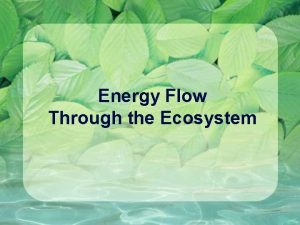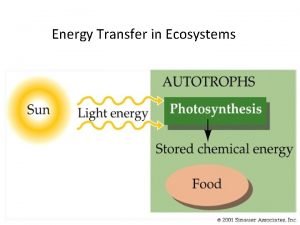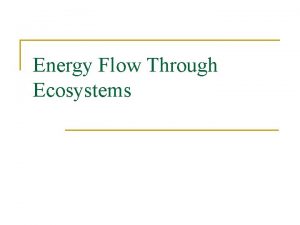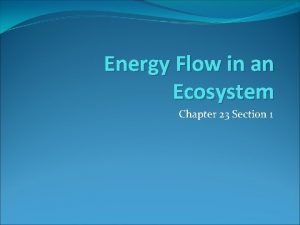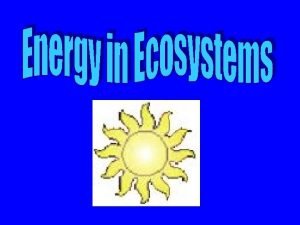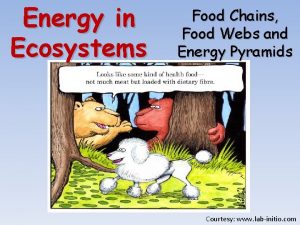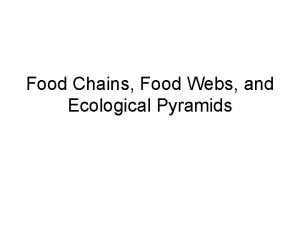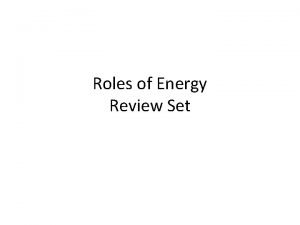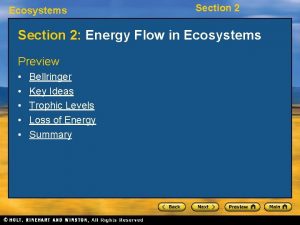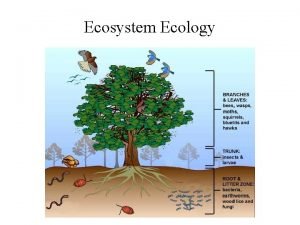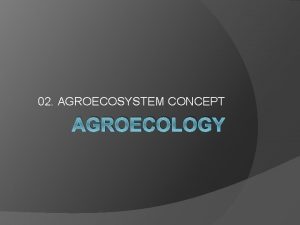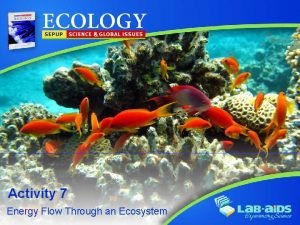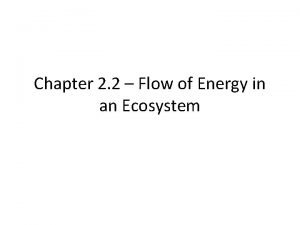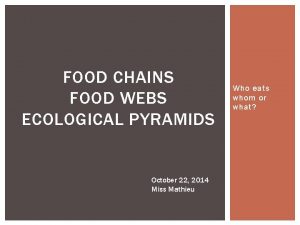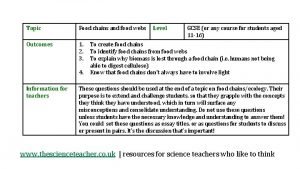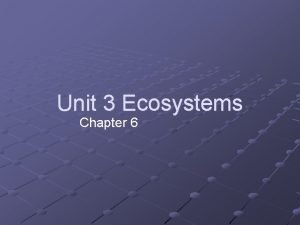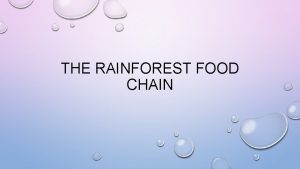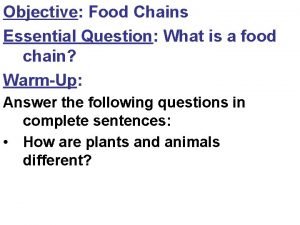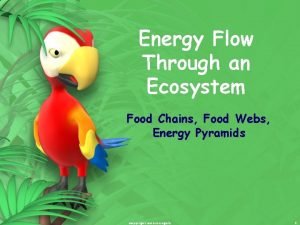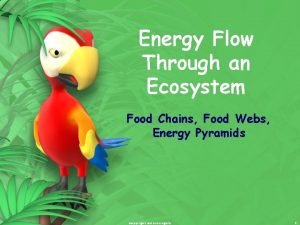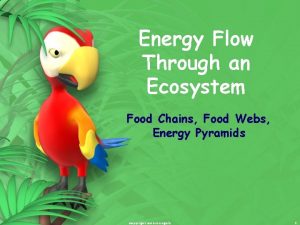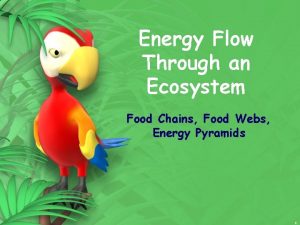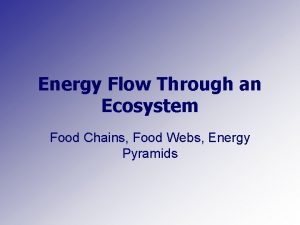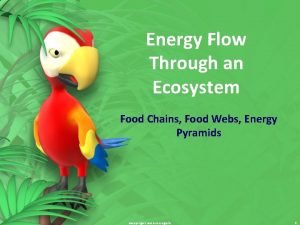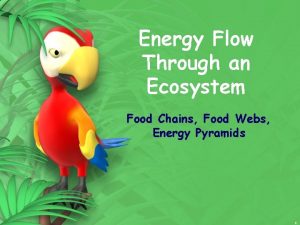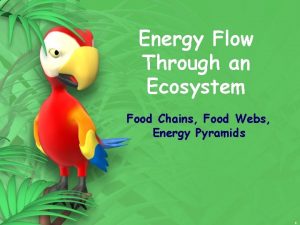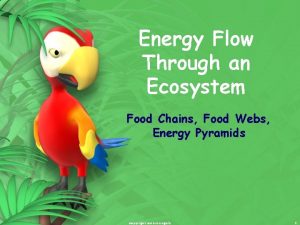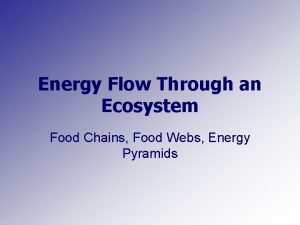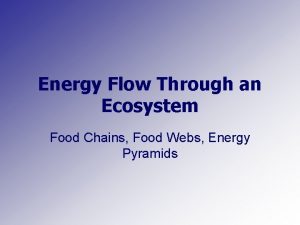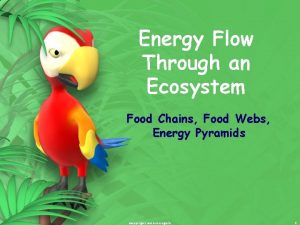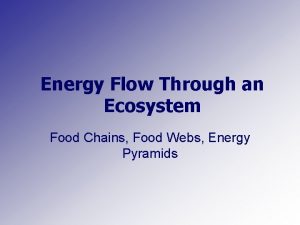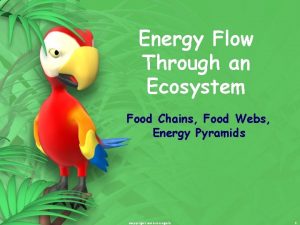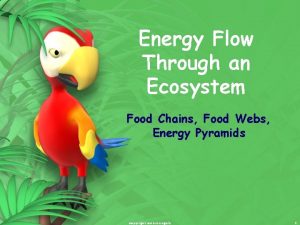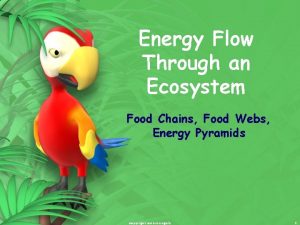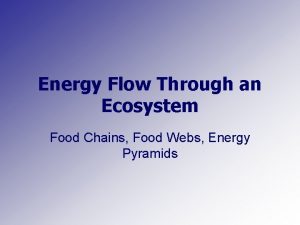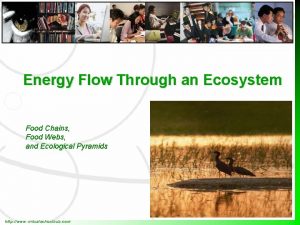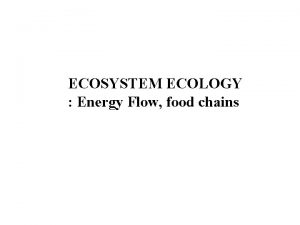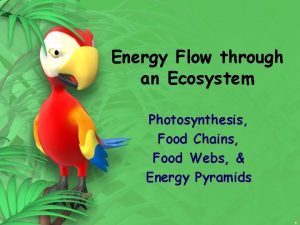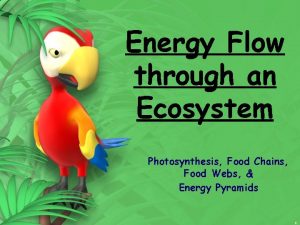Energy Flow Through an Ecosystem Food Chains Food





























- Slides: 29

Energy Flow Through an Ecosystem Food Chains, Food Webs, Energy Pyramids

Ecosystems • An ecosystem consists of all the living things and nonliving things in an given area.

Factors within an Ecosystem • Factors may be biotic or abiotic. • Biotic factors are the living things in an ecosystem such as bacteria, fungi, protists, plants, and animals. • Abiotic factors are the nonliving things in an ecosystem, such as sunlight, water, minerals, and oxygen.

Ecology • Ecology is the branch of biology that deals with the relations of organisms to one another and to their physical surroundings. • A scientist who studies ecology is considered to be an ecologist.

• Begins with the SUN • Photosynthesis 6 CO 2 + 6 H 2 O + sunlight & chlorophyll C 6 H 12 O 6 + 6 O 2

• The chemical reaction by which green plants use water and carbon dioxide and light from the sun to make glucose. • ENERGY is stored in glucose; glucose is stored as starch.

Niche • An organism’s role in its environment is called its niche.

Organisms that can make glucose during photosynthesis are called PRODUCERS.

Producers use most of the energy they make for themselves.

Producers use cellular respiration to supply the energy they need to live.

6 O 2 + C 6 H 12 O 6 --> 6 H 2 O + 6 CO 2 + energy CELLULAR RESPIRATION is the chemical reaction that releases the energy in glucose.

The energy that is not used by producers can be passed on to organisms that cannot make their own energy.

Organisms that cannot make their own energy are called CONSUMERS.

Consumers that eat producers to get energy: • Are first order or primary consumers • Are herbivores (plant-eaters)

Most of the energy the primary consumer gets from the producer is used by the consumer.

Some of the energy moves into the atmosphere as heat.

Some energy in the primary consumer is not lost to the atmosphere or used by the consumer itself. This energy is available for another consumer.

A consumer that eats another consumer for energy: • Is called a secondary or second order consumer • May be a carnivore • May be a predator • May be a scavenger

Most of the energy the secondary consumer gets from the primary consumer is used by the secondary consumer.

Some of the energy is lost as heat, but some energy is stored and can passed on to another consumer.

A consumer that eats a consumer that already ate a consumer: • Is called a third order or tertiary consumer • May be a carnivore • May be a predator • May be a scavenger

Consumers that eat producers & other consumers • Are called omnivores • Omnivores eat plants and animals

Consumers that hunt & kill other consumers are called predators. They animals that are hunted & killed are called prey.

Consumers that eat other consumers that have already died are called scavengers.

The transfer of energy from sun to producer to primary consumer to secondary consumer to tertiary consumer can be shown in a FOOD CHAIN.

Another way of showing the transfer of energy in an ecosystem is the ENERGY PYRAMID.

Energy pyramids show • That the amount of available energy decreases down the food chain • It takes a large number of producers to support a small number of primary consumers • It takes a large number of primary consumers to support a small number of secondary consumers


Food Webs: • Are interconnected food chains • They show the feeding relationships in an ecosystem
 How does energy flow through the ecosystem
How does energy flow through the ecosystem Energy transfer in ecosystem
Energy transfer in ecosystem Energy flow through an ecosystem
Energy flow through an ecosystem How does energy flow through an ecosystem
How does energy flow through an ecosystem Food chain desert
Food chain desert A series of events in which one organism eats another
A series of events in which one organism eats another Food chain
Food chain How does energy flow in an ecosystem
How does energy flow in an ecosystem Lab food chains and energy in ecosystems
Lab food chains and energy in ecosystems Transfer of energy between trophic levels
Transfer of energy between trophic levels Food webs and energy transfer
Food webs and energy transfer In a food web what do the arrows represent
In a food web what do the arrows represent As nutritional energy passes through the food chain, energy
As nutritional energy passes through the food chain, energy Section 2 flow of energy in an ecosystem
Section 2 flow of energy in an ecosystem Energy flow and material cycling in ecosystem
Energy flow and material cycling in ecosystem Agroecosystem concept
Agroecosystem concept Energy flow in ecosystem
Energy flow in ecosystem Describe the flow of energy in the kelp forest ecosystem
Describe the flow of energy in the kelp forest ecosystem Principles of ecology 2 flow of energy in an ecosystem
Principles of ecology 2 flow of energy in an ecosystem Food chain of producers and consumers
Food chain of producers and consumers Section 4: food chains and food webs
Section 4: food chains and food webs Food chains, food webs and ecological pyramids
Food chains, food webs and ecological pyramids Dessert food chain
Dessert food chain How many food chains are there in the food web
How many food chains are there in the food web Difference between food webs and food chains
Difference between food webs and food chains Energy naturally flows from warmer matter to cooler matter
Energy naturally flows from warmer matter to cooler matter Flow of energy vs flow of matter
Flow of energy vs flow of matter Food web in cameroon
Food web in cameroon Deer's food chain
Deer's food chain Food web and food chain difference
Food web and food chain difference
